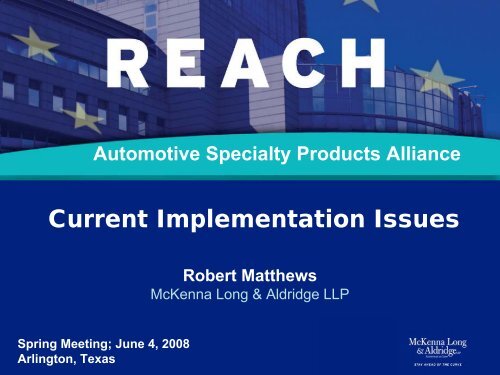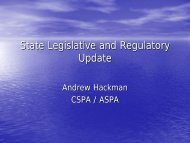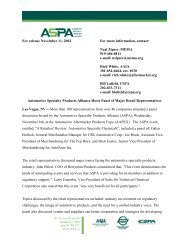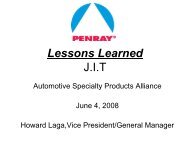US - Automotive Specialty Products Alliance
US - Automotive Specialty Products Alliance
US - Automotive Specialty Products Alliance
Create successful ePaper yourself
Turn your PDF publications into a flip-book with our unique Google optimized e-Paper software.
<strong>Automotive</strong> <strong>Specialty</strong> <strong>Products</strong> <strong>Alliance</strong><br />
Current Implementation Issues<br />
Robert Matthews<br />
McKenna Long & Aldridge LLP<br />
Spring Meeting; June 4, 2008<br />
Arlington, Texas
REACH Myths<br />
• REACH is a chemical industry issue<br />
• REACH is an EU-based company problem<br />
• REACH impacts U.S. exporters, but not their<br />
suppliers<br />
• REACH is an ES&H issue<br />
• U.S.-based components of multi-national corporations<br />
face the same challenges as their EU colleagues<br />
• U.S.-based components of multi-national corporations<br />
can rely on their EU colleagues for REACH training,<br />
planning, compliance<br />
ASPA Spring Meeting<br />
June 4, 2008<br />
2
REACH Realities<br />
• REACH poses business risk to any company doing<br />
business in the EU (and likely others)<br />
• Business continuity can be adversely impacted by<br />
REACH; supply chains can be disrupted; you can lose<br />
market access in the EU<br />
• Suppliers that are not willing/able to provide<br />
information to U.S. exporters risk losing their<br />
customers<br />
• Companies that understand the business implications<br />
and impacts of REACH, and develop strategic action<br />
plans, will gain a competitive edge over those that do<br />
not<br />
ASPA Spring Meeting<br />
June 4, 2008<br />
3
CURRENT REACH PRESSURE<br />
POINTS<br />
• Phase-in substances/pre-registration<br />
• Supply chain/due diligence<br />
• SVHCs<br />
ASPA Spring Meeting<br />
June 4, 2008<br />
4
First Critical REACH Milestone<br />
• Pre-Registration<br />
– Essentially a ‘grandfathering’ provision for chemicals<br />
already on the market in the EU (“phase-in<br />
substances”)<br />
– Significantly defers deadline for full registration<br />
– Data requirements limited; procedures simple<br />
– BUT: must pre-register between June 1 and<br />
December 1 2008<br />
ASPA Spring Meeting<br />
June 4, 2008<br />
5
Phase-In Substances<br />
• A substance is a phase-in substance if it<br />
meets one of the following criteria:<br />
– EINECS listed or<br />
– Over 15 years preceding the entry into force<br />
of REACH, manufactured in the EU but not<br />
marketed by manufacturer/importer or<br />
– “No longer polymers”<br />
ASPA Spring Meeting<br />
June 4, 2008<br />
6
Phase-In Substances (cont’d)<br />
• Deferred Registration for Phase-In<br />
Substances:<br />
– December 2010:<br />
ASPA Spring Meeting<br />
June 4, 2008<br />
• CMRs Category 1 and 2<br />
• R 50/53 (very toxic to aquatic organisms) >100<br />
tonnes/year and<br />
• >1000 tonnes per year<br />
– June 2013: >100 tonnes/year<br />
– June 2018: >1 tonne/year<br />
7
Phase-In Substances (cont’d)<br />
• To secure phase-in status, M/I must first preregister<br />
the substance<br />
• Timing of pre-registration – 6 month window<br />
– 1 June ’08 – 1 December ‘08<br />
• Failure to pre-register results in loss of phase-in<br />
status<br />
– M/I of phase-in substance must begin full registration<br />
process 12 months after EIF (June ’08)<br />
– See Guidance on Registration: as of 1 June ‘08,<br />
M/I must cease operations; may restart only after<br />
dossier submitted and deemed complete<br />
8<br />
ASPA Spring Meeting<br />
June 4, 2008
Phase-In Substances (cont’d)<br />
• Data Requirements (the easy button)<br />
– Name of substance, plus EINECS/CAS<br />
numbers<br />
– Identification of registrant<br />
– Registration deadline (tonnage band)<br />
ASPA Spring Meeting<br />
June 4, 2008<br />
9
Phase-In Substances/Pre-registration<br />
Anticipating Future EU Business Growth<br />
• Currently < 1 tonne, or even at 0<br />
• But plan to increase sales into the EU in<br />
the foreseeable future<br />
• Options<br />
– Pre-register now<br />
– Defer pre-registration<br />
ASPA Spring Meeting<br />
June 4, 2008<br />
10
Phase-In Substances/Pre-registration<br />
(cont’d)<br />
Anticipating Future EU Business Growth<br />
(cont’d)<br />
• Option #1 – Pre-register now<br />
– Based on “intent” to cross 1 tonne threshold<br />
prior to June 2018<br />
– No proof of “intent” required<br />
– No obligation to Register if you never cross 1<br />
tonne threshold<br />
ASPA Spring Meeting<br />
June 4, 2008<br />
11
Phase-In Substances/Pre-registration<br />
(cont’d)<br />
Anticipating Future EU Business Growth<br />
(cont’d)<br />
• Option #2 – Pre-register when growth<br />
plan is realized<br />
– Late market entrants can obtain phase-in<br />
status if they submit required information<br />
• Within 6 months after crossing 1 tonne threshold<br />
• No later than 12 months before applicable<br />
registration deadline (3.5, 6, or 11 years)<br />
ASPA Spring Meeting<br />
June 4, 2008<br />
12
Supply Chain/Due Diligence<br />
• Communications with Suppliers<br />
– General awareness of REACH<br />
– Substance identification (CBI issues)<br />
– Declaration of intent regarding registration<br />
– Contract provisions<br />
– Presence of SVHCs<br />
• Performance specifications<br />
– Changes in substances/concentrations<br />
ASPA Spring Meeting<br />
June 4, 2008<br />
13
Supply Chain/Due Diligence (cont’d)<br />
Due diligence issues, i.e., how to:<br />
– Obtain accurate/complete information from multiple<br />
suppliers regarding hundreds (+/-) of substances<br />
– Verify accuracy/completeness of information<br />
received from suppliers<br />
– Account for unannounced changes in supplier<br />
formulations<br />
– Manage risk of inaccurate/incomplete information<br />
from suppliers<br />
ASPA Spring Meeting<br />
June 4, 2008<br />
14
Supply Chain/Due Diligence (cont’d)<br />
Contract Issues - Current contract language;<br />
review:<br />
• Substance identification<br />
• Pre-registration/registration commitment<br />
• Notice provisions<br />
– Commitments<br />
– Changes in substance identification<br />
• Materiality<br />
• Consequences – business disruption<br />
ASPA Spring Meeting<br />
June 4, 2008<br />
15
Supply Chain/Due Diligence (cont’d)<br />
If supply chain communications fail,<br />
what can/must you do to identify/<br />
quantify substances<br />
• Review publicly available information<br />
• Rely on “branch knowledge”<br />
• Conduct chemical analysis<br />
ASPA Spring Meeting<br />
June 4, 2008<br />
16
Supply Chain/Due Diligence (cont’d)<br />
Article Importers/SVHCs<br />
• Request supplier confirm<br />
presence/absence of SVHCs in the article<br />
• If supplier unable to do so<br />
• Request supplier to forward request up its<br />
supply chain<br />
• Request supplier provide you with upstream<br />
supplier contacts<br />
ASPA Spring Meeting<br />
June 4, 2008<br />
17
Supply Chain/Due Diligence (cont’d)<br />
Supply chain disruption/loss of market access<br />
– E.g., supplier failure/refusal to provide necessary<br />
information to customer/exporter<br />
– Exporter unable to register all substances<br />
– Options<br />
A. Change suppliers<br />
B. Substitute the substance/preparation<br />
C. Move (more) production from U.S. to EU<br />
A shared problem that needs shared solutions<br />
ASPA Spring Meeting<br />
June 4, 2008<br />
18
Supply Chain/Due Diligence (cont’d)<br />
Geography Lesson<br />
• U.S. company ships preparations to its EU facility,<br />
where final article is assembled<br />
• Substances in preparations received from U.S.<br />
suppliers<br />
– Who will register<br />
– CBI issues (supplier provides preparation)<br />
• If, instead, U.S. company moves entire production<br />
either to U.S. (ships final article to EU) or to EU (no<br />
shipment of preparation from U.S. to EU)<br />
– Problem solved<br />
ASPA Spring Meeting<br />
June 4, 2008<br />
19
Substances of Very<br />
High Concern (SVHCs)<br />
• Registration (30,000 substances)<br />
• Evaluation<br />
• Authorization (1,500 substances)<br />
• Restrictions<br />
ASPA Spring Meeting<br />
June 4, 2008<br />
20
SVHCs<br />
Authorization<br />
• Category 1 and 2 Carcinogens (C)<br />
• Category 1 and 2 Mutagens (M)<br />
• Category 1 and 2 Reproductive Toxicants (R)<br />
• Persistent, Bioaccumulative, Toxic (PBT)<br />
• Very Persistent, Very Bioaccumulative (vPvB)<br />
• Substances with Equivalent Concerns<br />
– e.g., Endocrine Disruptors<br />
ASPA Spring Meeting<br />
June 4, 2008<br />
21
Authorization (cont’d)<br />
Substances placed on Annex XIV<br />
• If on Annex XIV, substance may not be<br />
placed on the market after “sunset date”<br />
• By a manufacturer, importer or downstream<br />
user<br />
• Unless specific use authorization provided<br />
– Application > 18 months before sunset date<br />
ASPA Spring Meeting<br />
June 4, 2008<br />
22
Authorization (cont’d)<br />
The Candidate List<br />
• Purpose is to identify substances “for<br />
eventual inclusion in Annex XIV”<br />
• Substances meeting the criteria for<br />
authorization<br />
• Based on review of Annex XV dossier<br />
• Likely publication: late ’08 → ‘09<br />
ASPA Spring Meeting<br />
June 4, 2008<br />
23
Authorization (cont’d)<br />
Candidate List Impacts – Deselection<br />
• Listing of 1500+ substances beginning in<br />
late ’08 → ’09<br />
• Annex XIV listing of some substances may<br />
be 1 to 5 decades later<br />
• In the interim<br />
• Customer deselection<br />
• For consumer products – self deselection<br />
ASPA Spring Meeting<br />
June 4, 2008<br />
24
Authorization (cont’d)<br />
Substances placed on Annex XIV<br />
• If on Annex XIV, substance may not be<br />
placed on the market after “sunset date”<br />
• By a manufacturer, importer or downstream<br />
user<br />
• Unless specific use authorization provided<br />
– Application > 18 months before sunset date<br />
ASPA Spring Meeting<br />
June 4, 2008<br />
25
Authorization (cont’d)<br />
Applications for Specific Use Authorization<br />
(Article 62)<br />
• Must include<br />
– Specific uses, including in preparations and articles<br />
– Chemical Safety Report<br />
– Analysis of alternatives<br />
– R&D information<br />
– If suitable alternative is available - a substitution<br />
plan<br />
ASPA Spring Meeting<br />
June 4, 2008<br />
26
Authorization (cont’d)<br />
Granting of Authorizations (Article 60)<br />
• Authorization shall be granted if<br />
– Risks to human health and/or the environment are<br />
adequately controlled<br />
– Taking into account discharges, emissions and<br />
losses, including risks from diffuse or dispersive<br />
uses<br />
OR<br />
ASPA Spring Meeting<br />
June 4, 2008<br />
27
Authorization (cont’d)<br />
Granting of Authorizations (cont’d)<br />
• If risks cannot be adequately controlled,<br />
authorization may still be granted<br />
– Socio-economic benefits outweigh the risks<br />
ASPA Spring Meeting<br />
June 4, 2008<br />
IF<br />
AND<br />
– There are no suitable alternative substances or<br />
technologies<br />
– Makes application of the "substitution principle"<br />
mandatory<br />
28
Authorization (cont’d)<br />
Granting of Authorizations (cont'd)<br />
• Only for the person(s) to whom authorization<br />
granted<br />
• Only for uses authorized<br />
• Conditions on use<br />
• Time limits<br />
These all create limitations/restrictions<br />
ASPA Spring Meeting<br />
June 4, 2008<br />
29
Authorization (cont’d)<br />
Substitution<br />
• If judgment is made that risks are not<br />
adequately controlled, submission of<br />
substitution plan becomes mandatory<br />
• NGOs<br />
– Can “point out there are substitutes<br />
available”<br />
ASPA Spring Meeting<br />
June 4, 2008<br />
30
CURRENT REACH CONTROVERSIES<br />
• Only Representatives<br />
• Monomers in Polymers<br />
• Substances in Articles<br />
ASPA Spring Meeting<br />
June 4, 2008<br />
31
Only Representative<br />
• Only representative can be appointed<br />
importer by non-EU<br />
– Manufacturer of substances<br />
– Formulator of preparations<br />
– Producer of articles<br />
• Only representative takes on Registration<br />
and other REACH responsibilities<br />
ASPA Spring Meeting<br />
June 4, 2008<br />
32
Only Representative (cont’d)<br />
Why use an only representative<br />
• Solve customer as importer problem<br />
• Solve confidential business information<br />
(CBI) problem, i.e., avoid disclosure of<br />
proprietary information by<br />
– Exporter to its EU customer<br />
– Supplier to the exporter (its customer)<br />
ASPA Spring Meeting<br />
June 4, 2008<br />
33
Only Representative/Substances<br />
U.S.<br />
EU<br />
U.S. Substance Manufacturer<br />
(A and B) (High Value<br />
Substances R Us, Inc.)<br />
Substance<br />
Customer X<br />
(B only)<br />
EU Substance Manufacturer (A)<br />
(Low Cost Substances R Us)<br />
Substance<br />
Customer Y<br />
ASPA Spring Meeting<br />
June 4, 2008<br />
34
Only Representative/Substances<br />
The simpler case - problems confronting<br />
U.S. exporter<br />
1. Customer as Importer<br />
• Customer in EU must register substances A & B<br />
2. CBI<br />
• In order for EU customer to register, it must know<br />
exactly what is in the materials it receives<br />
• Exporter must disclose proprietary formula<br />
Solution – the Only Representative<br />
ASPA Spring Meeting<br />
June 4, 2008<br />
35
Only Representative/Substances<br />
U.S.<br />
EU<br />
Only<br />
Representative<br />
U.S. Substance Manufacturer<br />
(A and B) (High Value<br />
Substances R Us, Inc.)<br />
Substance<br />
Customer X<br />
(B only)<br />
EU Substance Manufacturer (A)<br />
(Low Cost Substances R Us)<br />
Substance<br />
Customer Y<br />
ASPA Spring Meeting<br />
June 4, 2008<br />
36
Only Representative/Substances<br />
U.S.<br />
EU<br />
EU Substances<br />
Manufacturer (A and B)<br />
(Substances R Us, Ltd.)<br />
U.S. Substance Manufacturer<br />
(A and B) (High Value<br />
Substances R Us, Inc.)<br />
Substance<br />
Customer X<br />
(B only)<br />
EU Substance Manufacturer (A)<br />
(Low Cost Substances R Us)<br />
Substance<br />
Customer Y<br />
ASPA Spring Meeting<br />
June 4, 2008<br />
37
Only Representative/Preparations<br />
U.S.<br />
EU<br />
U.S. Supplier,<br />
Preparation A<br />
U.S. Preparation<br />
Manufacturer<br />
(Mixtures R Us, Inc.)<br />
Preparation<br />
Customer X<br />
Preparation<br />
Customer Y<br />
U.S. Supplier,<br />
Preparation B<br />
Preparations<br />
Manufacturer<br />
(Mix and Match R Us)<br />
ASPA Spring Meeting<br />
June 4, 2008<br />
EU Supplier,<br />
Preparation A<br />
38
Only Representative/Preparations<br />
The more complex case - problems confronting<br />
U.S. exporter and its suppliers<br />
1. Customer as Importer (same as above)<br />
2. CBI<br />
• Suppliers assert formula is proprietary; will not<br />
disclose to their customer (the exporter)<br />
• Exporter cannot arrange for registration<br />
Solution – the Only Representative<br />
ASPA Spring Meeting<br />
June 4, 2008<br />
39
Only Representative/Preparations<br />
U.S.<br />
EU<br />
U.S. Supplier,<br />
Preparation A<br />
Only<br />
Representative<br />
U.S. Preparation<br />
Manufacturer<br />
EU Preparation<br />
Customer X<br />
EU Preparation<br />
Customer Y<br />
U.S. Supplier,<br />
Preparation B<br />
EU Preparation<br />
Manufacturer<br />
ASPA Spring Meeting<br />
June 4, 2008<br />
EU Supplier,<br />
Preparation A<br />
40
Only Representative/Preparations<br />
Solutions to upstream supplier/CBI<br />
problem:<br />
1. Customer and supplier enter into<br />
confidential disclosure agreement<br />
2. Supplier retains only representative (as<br />
above)<br />
3. Customer finds another supplier<br />
4. <br />
ASPA Spring Meeting<br />
June 4, 2008<br />
41
Monomers in Polymers<br />
• Polymers are exempt from registration,<br />
but<br />
• Monomers and other substances<br />
contained therein must be registered if<br />
– Present at 2% or more in the form of<br />
monomeric units and chemically bound<br />
substances; and<br />
– The total quantity per year is 1 tonne or<br />
above.<br />
ASPA Spring Meeting<br />
June 4, 2008<br />
42
Monomers in Polymers (cont’d)<br />
Exemption – Registration not required if the<br />
monomer has “already been registered by an<br />
actor up the supply chain”<br />
• EU supplier can include use by its EU customer<br />
(polymer manufacturer) – customer exempt<br />
• <strong>US</strong> supplier not a registrant<br />
– <strong>US</strong> customer (polymer manufacturer) can not<br />
be exempt<br />
ASPA Spring Meeting<br />
June 4, 2008<br />
43
Monomers in Polymers<br />
Litigation Status – October 11, 2007 Ruling<br />
• Standing affirmed in UK Court<br />
• Challenge to Article 6.3<br />
– An actor “up the supply chain” means an actor “in<br />
the present supply chain”<br />
– Scientific and legal validity of the monomer<br />
registration requirement – “a serious issue”<br />
– Issue to be referred to European Court of Justice<br />
(ECJ)<br />
– Timing – ECJ decision not likely before preregistration<br />
window closes<br />
ASPA Spring Meeting<br />
June 4, 2008<br />
44
Substances in Articles<br />
• Substances intended to be released under<br />
normal or reasonably foreseeable conditions<br />
of use must be registered if above 1 tonne<br />
per year<br />
• Substances contained in articles above<br />
0.1% w/w must be notified if they are<br />
included in candidate list and if above 1<br />
tonne per year<br />
ASPA Spring Meeting<br />
June 4, 2008<br />
45
Substances in Articles (cont’d)<br />
Exemptions<br />
• Neither Registration nor Notification required if<br />
a substance has “already been registered for<br />
that use”<br />
– Customer of <strong>US</strong> article manufacturer not exempt<br />
– Unless another EU M/I of same substance registers<br />
(for that use)<br />
• If notifier can exclude substance exposure to<br />
humans and the environment during the normal<br />
or reasonably foreseeable conditions of use<br />
(including disposal)<br />
ASPA Spring Meeting<br />
June 4, 2008<br />
46
Substances in Articles (cont’d)<br />
Three Threshold Issues<br />
1. For article definition purposes, when during the<br />
manufacturing process does a<br />
substance/preparation become an article<br />
2. For substance registration purposes, is a<br />
substance contained in an article properly<br />
characterized as separate from, or integral to,<br />
the article<br />
3. If it is a substance in an article, when is a<br />
release considered intentional<br />
ASPA Spring Meeting<br />
June 4, 2008<br />
47
Articles Issues<br />
Threshold Issue - Transition from<br />
Substance/Preparation to Article<br />
• Main Principle - If raw material does not yet have<br />
end use function (processing step required to give it<br />
shape that would render it useful for a final purpose)<br />
• Starting material is a substance/preparation<br />
• The result of the processing would become an article<br />
• A material has an end use function where it can be<br />
directly applied to carry out a function without further<br />
processing<br />
• It is an article<br />
• Even if further processing could take place<br />
ASPA Spring Meeting<br />
June 4, 2008<br />
48
Articles Issues (cont’d)<br />
Threshold Issues for Registration/ Notification -<br />
Is it a Substance/Preparation (S/P) in a<br />
container or carrier or a Substance in an<br />
article<br />
– If S/P in a container or carrier, must register each<br />
substance (> 1 tonne) – Article 6<br />
– If substance in an article<br />
• Register only if there is an intentional release (Article 7.1)<br />
• Notify – Candidate list substance present above a<br />
concentration of 0.1% w/w (Article 7.2)<br />
ASPA Spring Meeting<br />
June 4, 2008<br />
49
Articles Issues (cont’d)<br />
Substance/preparation in a container<br />
or carrier<br />
• Examples from guidance<br />
• Toner Cartridge<br />
• Toner = S/P; Cartridge = Container<br />
• Cleaning Wipe<br />
• Cleaning material = S/P; Cloth wipe = Carrier<br />
• Printer ribbon<br />
ASPA Spring Meeting<br />
June 4, 2008<br />
50
Articles Issues (cont’d)<br />
Substance in an Article (cont’d)<br />
• Examples from guidance<br />
• Thermometer<br />
• Some adhesive tapes<br />
• Batteries<br />
ASPA Spring Meeting<br />
June 4, 2008<br />
51
Articles – Intentional Release<br />
When is a release considered intentional<br />
• A release is intended when it contributes to a<br />
quality or minor function of the article<br />
– “Added value” not directly connected to the end use<br />
function of the article<br />
• Examples<br />
– Perfumed eraser (function is to erase; scent is<br />
added value)<br />
– Fade-out jeans (release of dyes during each<br />
washing is intended. Or is it)<br />
– New car smell (when added in production process)<br />
ASPA Spring Meeting<br />
June 4, 2008<br />
52
Articles – Intentional Release<br />
• A release is not intended<br />
– During removal of impurities from a semi-finished or finished<br />
article during its production process<br />
– During use or maintenance activities that are meant to improve<br />
product quality or safety<br />
– Unavoidable side effect<br />
• Examples<br />
– Size added to fabric to improve processability (released during<br />
further processing)<br />
– Clothes washing where chemical remnants from processing<br />
(e.g., dye) are released<br />
– Wear and tear/friction (break linings; tires)<br />
ASPA Spring Meeting<br />
June 4, 2008<br />
53
Substances in Articles – Information<br />
in the Supply Chain (Article 33)<br />
Suppliers of articles containing substances listed<br />
on the candidate list must provide sufficient<br />
information allowing safe use of the article<br />
(including, at a minimum, name of the substance)<br />
• to recipients of articles<br />
• to consumers<br />
– on request<br />
– within 45 days<br />
ASPA Spring Meeting<br />
June 4, 2008<br />
54
Article 33 (cont’d)<br />
• Article 33 obligations apply if the<br />
substance is present in article > 0.1% w/w<br />
• For Article 33 purposes, there is<br />
– No tonnage threshold<br />
– No Article 7(3) exemption (exclude<br />
exposure)<br />
– No Article 7(6) exemption (already<br />
registered for that use)<br />
ASPA Spring Meeting<br />
June 4, 2008<br />
55
Preparing for REACH<br />
ASPA Spring Meeting<br />
June 4, 2008<br />
56
Preparing for REACH<br />
Purpose<br />
• Obtain an overview of which REACH obligations<br />
apply to your company<br />
• Take strategic decisions about substances,<br />
products, suppliers and customers<br />
• Allocate responsibilities and funds<br />
• Incorporate “REACH think” into<br />
process/planning/decisions on R&D, alternatives,<br />
substitution<br />
ASPA Spring Meeting<br />
June 4, 2008<br />
57
Step 1 – Secure Management Buy-In<br />
• Engage corporate and division managers<br />
• Involve purchasing, sales/marketing, R&D,<br />
legal<br />
• Assign regulatory and business<br />
responsibilities<br />
• Train<br />
ASPA Spring Meeting<br />
June 4, 2008<br />
58
Step 2 – Conduct Training<br />
• At corporate, division, product levels<br />
• Across disciplines<br />
– Management, e.g., business, product<br />
– Regulatory specialists<br />
– Supplier and customer relationship managers<br />
– R&D personnel<br />
– Counsel<br />
ASPA Spring Meeting<br />
June 4, 2008<br />
59
Step 3 – Conduct Inventory Review<br />
• All substances, preparations, monomers in polymers,<br />
substances in articles<br />
• Manufactured, imported (e.g., export by U.S. company to<br />
EU affiliate), purchased<br />
• At legal entity level<br />
• Each EU affiliate may be a separate legal entity<br />
• Centralization advantages<br />
– classifications/SDS should be consistent;<br />
– strategic decisions about phase-out, reformulation and<br />
allocation of resources taken at corporate level<br />
ASPA Spring Meeting<br />
June 4, 2008<br />
60
Step 4 – Conduct Supplier/Customer<br />
Review<br />
Suppliers<br />
• Location<br />
• Willingness/ability to provide substance<br />
information<br />
• Willingness/ability to assume Registration role<br />
• Alternative suppliers<br />
• Communications with suppliers (see below)<br />
• Contract issues (see below)<br />
ASPA Spring Meeting<br />
June 4, 2008<br />
61
Conduct Supplier/Customer Review<br />
(cont’d)<br />
Customers (U.S.)<br />
• Willingness/ability to assume Registration<br />
role<br />
• Do they have alternative suppliers<br />
• SVHC/deselection issues<br />
• Communications with customers<br />
• Contract issues<br />
ASPA Spring Meeting<br />
June 4, 2008<br />
62
Conduct Supplier/Customer Review<br />
(cont’d)<br />
Customers (EU)<br />
• Uses/exposures<br />
• Willingness/ability to assume Registration role<br />
• Do they have alternative (EU) suppliers<br />
• SVHC/deselection issues<br />
• Communications with customers<br />
• Contract issues<br />
ASPA Spring Meeting<br />
June 4, 2008<br />
63
Step 5 – Develop Strategic Action Plan<br />
• Identification of key EU products/substances<br />
– Active role in SIEFs/consortia (lead registrant)<br />
– Registration by supplier customer affiliate only<br />
representative<br />
• Supplier issues<br />
– Geography issues<br />
– What do I need to do to secure supply chain<br />
– Will I need to streamline supply chain<br />
ASPA Spring Meeting<br />
June 4, 2008<br />
64
Develop Strategic Action Plan (cont’d)<br />
• Customer issues<br />
– How will REACH impact current customer<br />
relationships<br />
• U.S. customer (of U.S. supplier)<br />
• EU customer (of U.S. exporter)<br />
– New product/market challenges opportunities<br />
• For each product/substance<br />
– How does REACH impact my current and future market<br />
strategies<br />
– Are we in a position to create a REACH “win”<br />
ASPA Spring Meeting<br />
June 4, 2008<br />
65
Individual Company Efforts -<br />
Conclusion<br />
Process – Training, Inventory, Evaluation of<br />
Supply Chain, Planning<br />
Endpoint – Develop REACH Strategic Action<br />
Plan<br />
• At company, division, product and/or substance<br />
level<br />
ASPA Spring Meeting<br />
June 4, 2008<br />
66
Contact Information<br />
ASPA Spring Meeting<br />
June 4, 2008<br />
THANK YOU<br />
For further information, contact:<br />
Robert Matthews<br />
McKenna Long & Aldridge LLP<br />
1900 K Street, NW<br />
Washington, DC 20006<br />
202-496-7737<br />
rmatthews@mckennalong.com<br />
67









